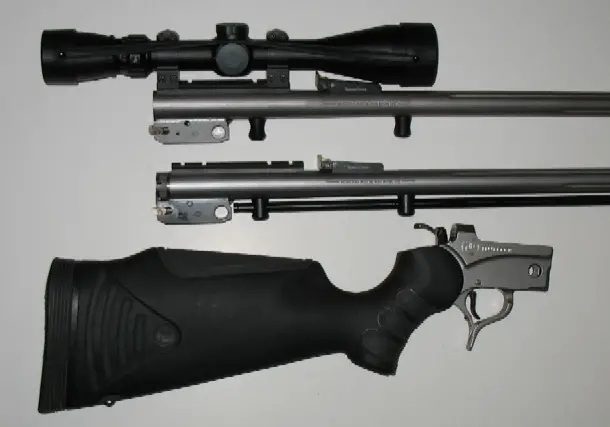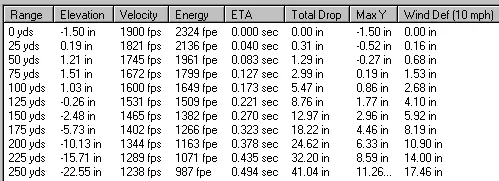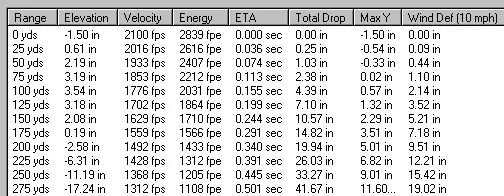


Review: Thompson Encore 209 x 50 Magnum Muzzleloader, Still the Mercedes?

The Thompson-Center Encore as a muzzleloader has an interesting background and it was almost never made. In discussions with Thompson's Eric Brooker, now retired, Eric mentioned that after the muzzleloader barrel was introduced for the Encore platform, they were making bets in the office as to whether they would ever sell fifty or one hundred muzzleloading barrels. There was some basis for the healthy dose of skepticism back then. The Encore platform was considered an overbuilt platform for a muzzleloader, as the Encore rifle has long been available in 7mm RemMag, .300 Winchester Magnum, and .375 H & H configurations. It was never going to be the cheapest frontstuffer on the block. The Encore frame is a firearm frame, meaning it is a Form 4473 controlled item-- you'll need to get your Encore from your favorite dealer, the complete Encore muzzleloader is considered a regular firearm and cannot be sold through many of the normal muzzleloading channels. That leaves out many typically smaller, archery, fishing, and specialty muzzleloading shops that have long sold T/C sidelocks and dedicated muzzleloaders but are not firearms emporiums.

Apparently, far more people wanted “real rifles” than Thompson expected. Unlike some muzzleloaders, the T/C Encore was never the object of any build quality shortcuts. It was the same frame regardless of barrel added to it. The 209x50 Magnum has always been offered with a Thompson, American made 4140 Chrome Moly barrel in its standard configuration. The blued steel and walnut model, T/C No 3842, is still offered today. It is actually a more attractive choice than ever before, as the latest blackpowder replacement propellants (Blackhorn 209) are not nearly as caustic, do not freeze breechplugs, and are very easy to clean up after shooting with a couple of patches soaked with Hoppe's No. 9 solvent. It was this model that became a preferred muzzleloader for many, with the appeal of excellent build quality, polished blue, and the look and feel of real walnut, all made in the United States. Ian McMurchy referred to it as “arguably the greatest value in inline muzzleloaders as the 1990s ended.” Ian further reported average group sizes at 100 yards of one inch with 250 grain T/C “PTX” sabots and .90 inches with 250 grain Barnes sabots in his “Muzzleloading for Today's Whitetails,” published in the year 2000.
The Encore has been the most copied muzzleloader in memory. So much so, that I referred to it as the “most influential rifle” in several articles and had this to say six years ago: “Thompson wins again this year with its Encore .50 caliber muzzleloader, for a different reason. While the Encore is by no means a new model, it has remained as one of the most sought after front loaders, and one of the very best. It selection as the most influential muzzleloader is uniquely easy, as the gush of new break-action rifles introduced in 2004 is directly attributable to the Encore's lasting success. Though the clear intent has been to capitalize on the Encore's lasting desirability, no break action muzzleloader has come close to the overall strength and quality of the Encore--” It was true in 2004 and, if anything, it is even more true today.
The world of "wannabe" Encores is a very thick one these days indeed. The October, 2010 issue of Gun Tests pitted a CVA Accura, CVA Scout, and an H & R against each other in .308, .30-06, and .308 respectively. If you get a chance, read the issue for yourself. The Bergara barreled CVA's were failboats in the accuracy department, as the economy shotgun-actioned H & R put them to shame. History repeats itself: accuracy is simply no accident.

There isn't much difference between the original Pro Hunter .50 caliber barrel (top) and the Endeavor barrel beneath it, except for the knurled "socketless" speed breech addition. The Encore frame and buttstock with Limbsaver pad weighs only about 2-3/4 lbs. Worth a comment are the excellent Encore iron sights, very easy to use even for these old eyes and far better than found on most muzzleloaders. The green fiber-optic ramp is closest to the eyes. Just for the same reason billiard cloth is green, it makes everything else stand out without distraction.
Tested and evaluated is the T/C “Pro Hunter” / Endeavor 209 x 50. There are several changes present in the Pro Hunter, many of them best called “modernistic treatments.” I'll run through the basics, starting with the breechplug and extractor. The Encore previously had no less than three breechplug designs, the changes attributable to both Hodgdon Triple Se7en issues and pellet issues. The first was a traditional treatment at the time, featuring a deeply dished-out cone at its face. This “Stage One” breechplug was fine for some loose powder propellants, but there was insufficient shoulder at the face to inhibit inadvertent cracking and smashing of pellets. Once pellets crack, things go haywire in resultant pressure and performance, to say the very least. So, as pellets became more and more popular, T/C offered the solid breechplug, the “Stage Two” breechplug that offered a generous support surface for the fragile pellets. That helped the pellet situation, but a new issue reared its head, helped along by the “new for 2002” or thereabouts Hodgdon Triple Se7en propellant. Triple Se7en propellant has a nasty habit of leaving behind a hard, slag-like fouling crud. It has become well-known as the “Crud Ring.”
Hodgdon long denied it ever existed, blaming it on bullet lubes and so forth. Sabots need no lubes, of course, and I've never lubed sabots. The nasty crud ring of doom was nobody's imagination. All kinds of pricey, proprietary 209 “black powder” primers have subsequently been introduced to try to contain the crud ring monster, none with complete success. Regardless, T/C had some cranky customers that were fighting pellets and crud rings, and the “Stage Two” breechplug addressed some of the pellet problems, but was a filthy mess on the business end with Triple Se7en. The T/C “Stage III” breechplug came out in short order. It was essentially the deeply coned Stage I plug with a shoulder added at the perimeter of the breechplug of sufficient width to give reasonable pellet support. The fouling from Triple Se7en was still there, but greatly reduced from the solid plug. It was the best compromise available, and was the predominant breechplug used in the Encore for many years, interchangeable with the Omega breechplug as well.
The new Pro Hunter added several features, as noted in this review from 2006: http://randywakeman.com/ThompsonProHunter.htm . It was still the most copied of the break-actions and remained the “Mercedes of Break Action Muzzleloaders” but despite the many attempted copies, the Encore remained the best of the breed by no small margin. This model was still, as originally reported, an MOA muzzleloader, right out of the box.
That brings up to the present, where the Endeavor model has apparently morphed into the “Pro Hunter XT.” It is the No. 5722 Pro Hunter XT, billed as new for 2010. The primary difference is of the “XT” is the addition of the latest XT speed breech, the same ninety degrees and out breechplug introduced om the Pro Hunter, but now with tool-free removal thanks to a generous knurled section on the breech side of the plug, dubbed the “Speed Breech XT.” A hand-removable version is also found on the T/C Triumph.
The Pro Hunter XT is .50 caliber, 1:28 rate of twist (the standard in inlines today), with a 14 inch length of pull, and an overall length of 42.5 inches. Though listed as 8.25 pounds, the tested model is actually substantially lighter at 7.5 pounds, unloaded. It has a “28 inch fluted barrel,” while the standard Encore 209 x 50 remains at 26 inches, and the 20 inch “Katahdin” barrel remains available for those seeking a more compact, slightly lighter, faster handling model.
This Encore has a trigger break of right at 4-1/4 pounds. Encores, as a generality, are not known for having hair triggers by any means. In this case, a slightly lighter than anticipated trigger combined with the wide trigger face of the Encore resulted in an excellent hunting trigger, right out of the box. After mounting a Sightron “Big Sky” 3-12 x 42mm scope with Warne Maxima quick detachable steel rings, it was off to the range. I began by using 100 grains by volume of Blackhorn 209 black powder sub with a Barnes T-EZ 290 grain flat based, polymer tipped bullet with the supplied Barnes sabot, the MMP HPH-24 in blue to match the polymer tip. Coni Brooks of Barnes has always believed “accessories make the ensemble” and all that, so Barnes bullets look good and are well-packaged. I'm of more pedestrian tastes, I just care how they shoot. Anyway, the Barnes T-EZ 290 loaded perfectly in the Encore, and the first three shots at 100 yards were all touching for a C-T-C group of about 7/8 of 1 inch. Sightron scopes generally go where you tell them. As I already had a group worth moving it was a simple matter to move it to one inch directly over the bull at 100 yards. Complete sight-in of this rifle took all of 15 minutes.
There are hunts coming up in deep timber, so really I was done. But, the Encore is easy and fun to shoot, so another 40 or so rounds were fired. There was no noticeable change in group size from 100 to 105, to 110 grains by volume of Blackhorn 209. I found 105 grains by volume to be just right in terms of repetitive shooting from bag and cradle, so that's what I finally settled on. The 105 grains by volume on a T/C U-View blackpowder powder measure equates to an average of about 1900 fps MV and 71 grains of actual weight by RCBS Chargemaster 1500. One of the advantages of using weighed charges is that weight actually means something . . . volumetric measures of different brands don't always agree, a nice understatement. Weight at least means something and that something is verifiable.
Approximate ballistics of this one inch high load areas follows. It is center of the body hold to 155 yards with no adjustments, more range than needed in thick timber.

When the opportunity for longer ranges is anticipated, the Jack O'Connor standard of center of the body hold, six inch kill maximum point blank range exterior ballistics looks, again approximately, like this. It is center of the body hold and go pick him up out to 180 yards.

Some folks are of the "faster is always better" school. I'm not one of them, but for sake of completeness I'll mention that you can easily load the Encore to 2100 fps, with Blackhorn 209, pushing the same Barnes T-EZ 290 sabot. Those numbers are approximately shown on the following chart.

The above takes a bit more aggressive, 7 inch kill zone to go along with the 2100 fps muzzle velocity yielding point and pick him up to 207 yards with no holdover. It also reveals one of the biggest considerations at long range: windage. A 10 mph crosswind blows the projectile over fifteen inches at 250 yards, make it 20 mph and it is an unmanageable amount of wind drift, nearly 31 inches.
Clean up after shooting, with Blackhorn 209, takes but a few moments. All that is required is two wet patches of Hoppe's No. 9 with a 28 gauge bore brush followed by a dry patch and you are done. If you are planning on storing your Encore for a while, then you might want to clean and relube your breechplug and give the bore one patch of Montana Xtreme Gun Oil or Breakfree CLP. The only other thing to check periodically is carbon build up inside the breechplug. Soaking it in Slip 2000 followed by a light reaming with the appropriate drill bit keeps the flame path through the breechplug unobstructed and efficient for positive ignition.
The Encore, while not completely silent when you cock the hammer, is far more quiet than several exposed hammer guns, including the now-obsolete Knight Rolling Block and the Knight KP-1 break action. The Encore is also a clean half pound lighter than either. What you might notice is that T/C remains the only real innovator in break-action muzzleloaders. Just as soon as Thompson offered a quick release breechplug, for example, the copyists tripped all over themselves trying to offer a version of their own. More to the point, a quick look shows all the important areas they have missed.
The dual spring loaded lugs on the Encore action are two piece as a one piece spring loaded lug locks up so tight, the barrel is nearly impossible to open. With double spring loaded lugs, one lug or the other will free itself first, making the action easy to open while still retaining the vault like strength of the full lug lock-up area, strong enough for the .375 H & H. Thompson introduced the speed breech, requiring only a quarter turn to remove the breechplug. Now, there are other so-called “speed breech” copies out there. The problem is that they aren't fast at all, requiring several complete turns to remove. Calling a half-fast breechplug a “quick release” breechplug makes no sense, but score another point for marketing over intelligence. Even the triple lead breechplug found on the entry-level T/C Impact comes out faster and easier than other breechplugs labeled as quick release and so forth.
The Encore, regardless of configuration, has an extractor for the 209 primer. After the shot, the idea is to make the spent 209 primer "go away" without conscious effort, removing the possibility of a stuck primer or having to fish, dig, or fight to get a used primer out of a hole. Other break actions don't bother with an extractor, skimping yet again where it counts. The same is true with the T/C “QLA” false muzzle, long enough to align a saboted projectile without canting. The smaller QLA copies found on cheap, imported guns are worse than no false muzzle at all, having insufficient length to quickly align a saboted projectile properly. Too often, they are machined eccentric to the bore, the result of which is destroyed accuracy. You might think after all these years, the guns made to capitalize on the popular look and feel of the Encore would at least add something of value. They haven't yet, no break action muzzleloader comes close to the Encore, they just keep falling further back. Actually, I did have high hopes for the now-discontinued Knight KP-1. Initial trigger problems, a truly filthy internal blowback breechplug, and an extractor that didn't extract held it back from what it could have been.
Limbsaver recoil pads have long been among my favorites. The Limbsaver works well on the Pro Hunter XT, and the large trigger guard and the generous trigger guard makes the Encore easy and intuitive to use, even with cold, gloved hands. It is these same cold, gloved, or wet hands that appreciate an extractor rather than playing tiddly-wink with a primer. The “Swing Hammer,” or three position hammer is retained on the Pro Hunter XT. There was still plenty of clearance between the Sightron Big Sky 3-12 x 42, mounted with Warne medium Maxima QR rings with the hammer in the center position for hassle-free operation. In this case, the swing hammer was unnecessary. Contingent on specific scope, you might find this feature to be of value but so far, I have not.
Now, with Blackhorn 209, the Encore is easier and more fun to use than ever. Made in the USA, as always, with barrel quality monitored by Thompson's proprietary continuous Magnafluxing process, the Encore remains better than ever, and if anything, more ahead of the pack then ever. My earliest Encores shot inside an inch, the tested example from 2006 did the same, and this model happily shot 7/8 inch groups (and a couple of groups right at 1/2 inch C-T-C) with almost no load work-up. Thompson still offers a lifetime warranty to the original purchaser. So, yes, the Encore remains the "Mercedes of Break Action Muzzleloaders" today, and the best conventional inline muzzleloader that can be had in 2010. It has quality and attention to detail that is easy to appreciate, something you'll appreciate more and more as the years go by. It is built like a real rifle, for that is what it always has been. Few muzzleloaders have ever been remotely in the same league; no break-actions made today are. Congratulations to Thompson-Center Arms.
Copyright 2010 by Randy Wakeman. All Rights Reserved.


